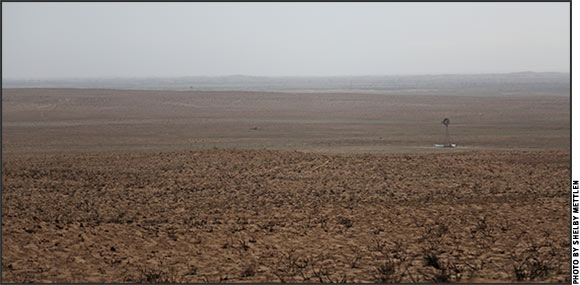
Faith After Fire
A trip to southwest Kansas shows how devastation brings communities closer.
Entering Clark County, Kan., you’re greeted by a sign reading, “Fire damage ahead. Use caution.” It doesn’t completely prepare you for the charred, twisted fences and scorched earth that follow. Nearly a month after the devastating March 6 wildfires that swept through counties in Texas, Oklahoma, Colorado and Kansas, shoots of green grass are beginning to appear from the dust and the ash.
In Clark and Comanche counties alone, the area hardest hit, fires burned an estimated 484,000 acres, 461,000 of those in Clark County. Hundreds of miles of fence were destroyed, thousands of cattle perished and more than 100 structures, including homes, bridges and outbuildings, were lost. A truck driver died in Kansas, and as many as six more lives were lost in Texas and Oklahoma. Read more.

Kurt Kangas
Association Perspective
Create a vegetation management plan to increase your bottom line.
Spring is finally starting in the Northwest. Calving season is winding down, and cows and bulls are looking forward to spending quality time together on greener pastures. Without a doubt, springtime on a ranch is an extremely busy time of year. Calving, branding, breeding, fencing, seeding … the list goes on and on. It’s also an important time to review or create a vegetation management plan for the ranch.
Doing an initial inventory is best done in the summer months when vegetation is at its peak production. However, taking inventory of noxious weeds can begin in early spring. On rangeland in the West, the spread of noxious weeds has been ongoing for decades. Read more.
Farm Bankruptcies Could Rise
Declining farm income and farmland values may cause issues.
Declining farm income and farmland values likely will lead to an increase in the number of farmers who are delinquent on their loans and eventually a rise in farm bankruptcies, predicted a pair of Ohio State University agricultural economists.
While the current farm bankruptcy rate is low, at two per 10,000 farms nationally, that rate has gone up slightly in recent years and likely will continue to do so, said Ani Katchova and Robert Dinterman, both from the College of Food, Agricultural and Environmental Sciences.
Bankruptcy rates seem to be a lagging indicator of financial stress after debt levels rise and delinquencies on agricultural loans increase, Katchova, Ohio State’s farm income enhancement chair, pointed out. Read more.
Beef Sustainability Metrics Taking Shape
Six high-priority indicators to measure sustainability by sector have been identified by the multi-stakeholder members of USRSB.
As the topic of sustainability continues to be discussed within the agricultural industry, the U.S. Roundtable for Sustainable Beef (USRSB) is moving forward with developing metrics to assess sustainable practices within each sector of the beef value chain.
Ben Weinheimer, vice president of the Texas Cattle Feeders Association and co-chair of the Sustainability Indicators Working Group within the USRSB, provided an update to cattle industry representatives attending the February 2017 Cattle Industry Convention in Nashville, Tenn. Read more.
What’s Inside …
In this April edition of the Angus Beef Bulletin EXTRA, you'll find valuable articles devoted to the management, marketing, and health and nutrition of your beef enterprise. Select from the tabs at the top of the page to access this month’s entire offering by category. A few select features include:
- 25 Years of NBQA
- Tips for Working with the BLM and Forest Service
- 4 Keys for Effective Probiotic Use
- Supplementing Body Condition Score
- Managing Herd Security, BVD
- Vaccinating Calves
- Efforts to Promote Beef Nutrition and Health Benefits Reviewed
- In The Cattle Markets
- On Target: Expanding cows or herds
News Briefs …
The American Angus Association and its subsidiaries generate a wealth of information to keep members and affiliates informed of what's happening within the industry, as well as with the programs and services they offer. Click here for easy access to the newsrooms of the American Angus Association and Certified Angus Beef LLC and the Angus Journal Daily archive available in the API Virtual Library.
Business Succession Planning Tools
Create a plan and keep that plan up to date.
Business planning succession is often avoided due to fear, noted Michael McCormack as he addressed cattle producers attending a Learning Lounge session offered Feb. 2 at the 2017 Cattle Industry Convention & NCBA Trade Show in Nashville, Tenn.
McCormack, a financial advisor with Lincoln Financial Agribusiness, explained that the most common “fear” scenario he sees among family businesses — such as farms and ranches — is that the owners do not teach the next generation how to run the company because they do not want to lose control. Read more.
![]()
Special section on survival finds significant improvement for all but two cancer sites.
Overall cancer death rates continue to decrease in men, women and children for all major racial and ethnic groups, according to the latest Annual Report to the Nation on the Status of Cancer, 1975-2014. The report finds that death rates during the period 2010-2014 decreased for 11 of the 16 most common types of cancer in men and for 13 of the 18 most common types of cancer in women, including lung, colorectal, female breast and prostate cancers.
Meanwhile, death rates increased for cancers of the liver, pancreas and brain in men and for liver and uterine cancer in women. The report finds overall cancer incidence rates, or rates of new cancers, decreased in men but stabilized in women during the period 1999-2013. Read more.






